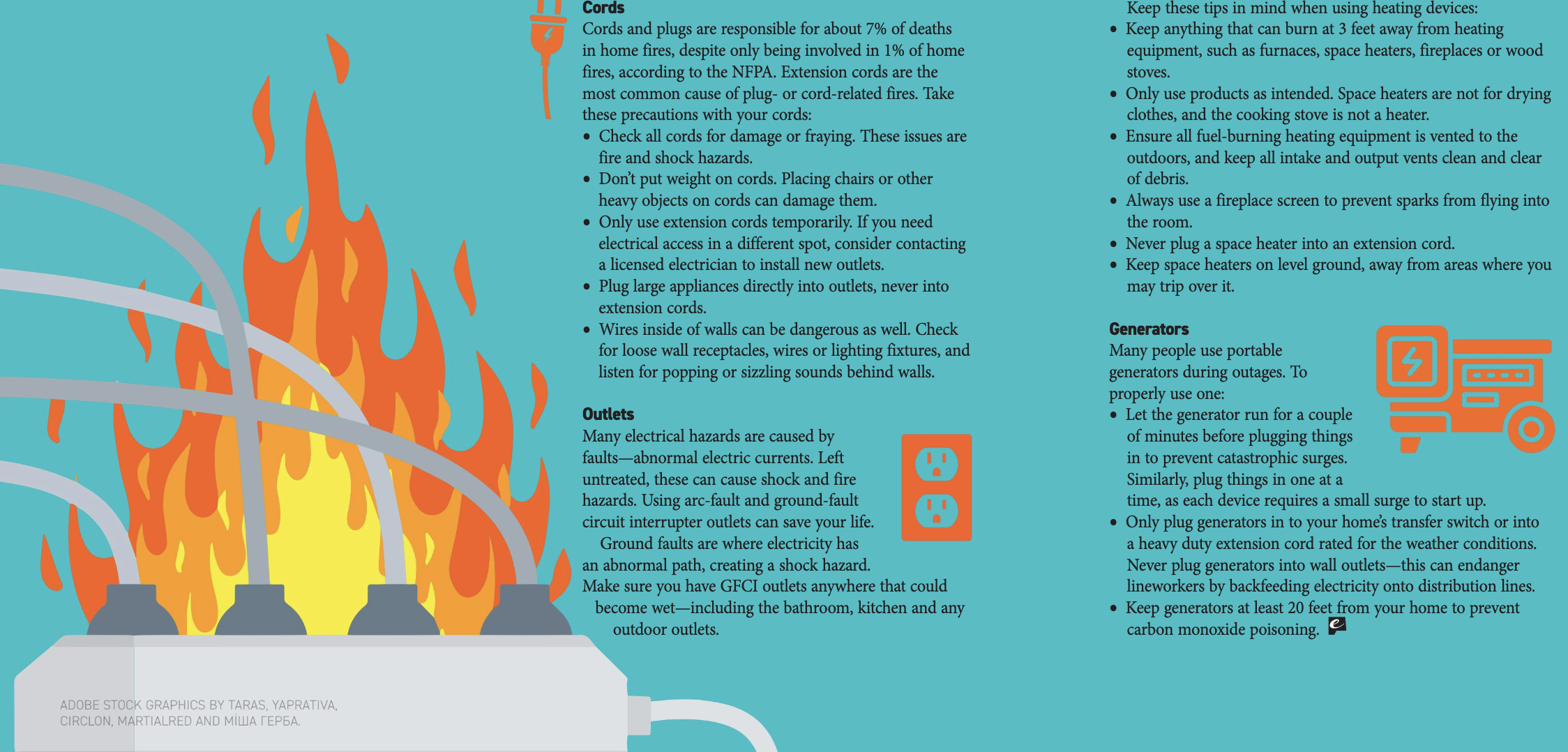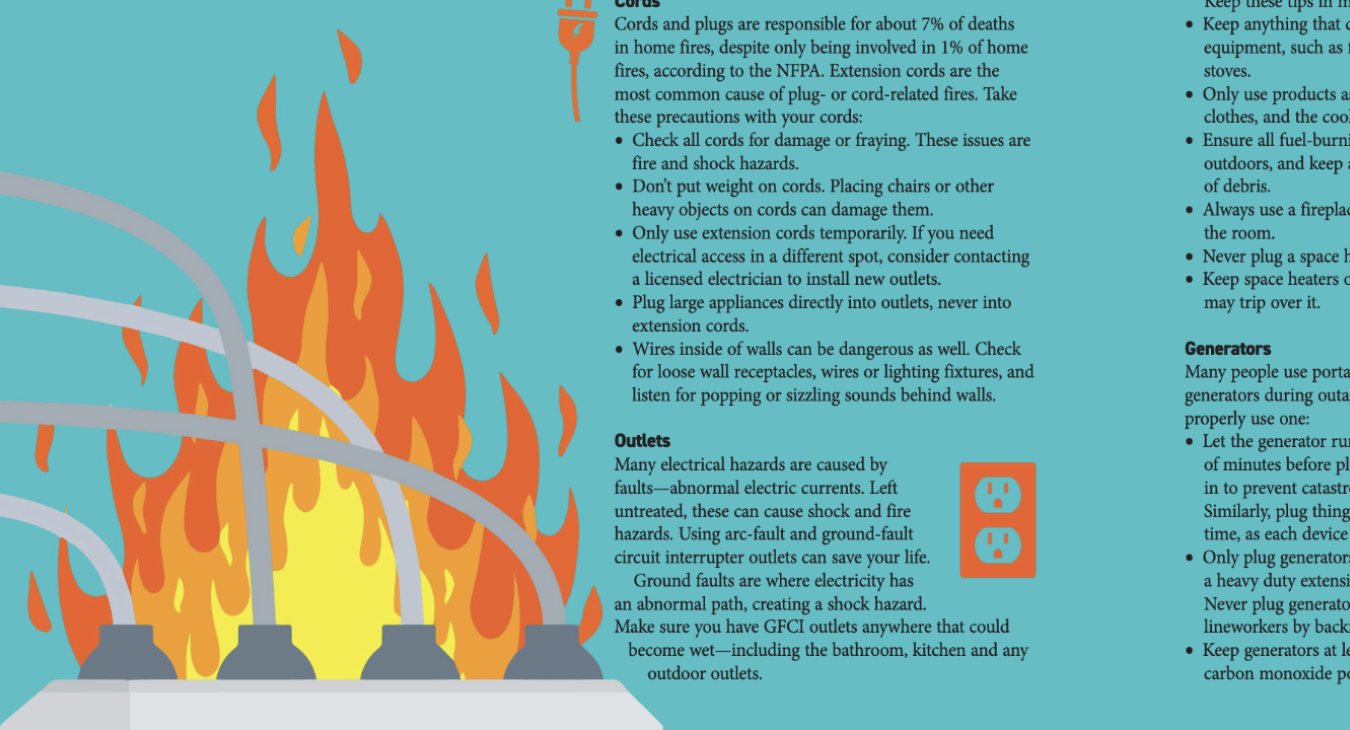Keep Your Cool
Give your home an annual safety checkup to stay a step ahead of electrical fires
By David Herder
Being home can mean having a warm and cozy spot to rest while winter weather rages outdoors. However, your home can turn from toasty to toast in an instant if a fire breaks out.
Electrical failures and malfunctions were factors in more than 30,000 fires a year from 2015–2019, according to the National Fire Protection Association. Annually, those fires caused 430 deaths, 1,070 injuries and $1.3 billion in property damage.
The new year presents an opportunity to build new habits and safeguard your home. Give your home an electrical safety checkup to keep it how you like it—warm, safe and free of electrical fire hazards.
Cords
Cords and plugs are responsible for about 7% of deaths in home fires, despite only being involved in 1% of home fires, according to the NFPA. Extension cords are the most common cause of plug- or cord-related fires. Take these precautions with your cords:
-
Check all cords for damage or fraying. These issues are fire and shock hazards.
-
Don’t put weight on cords. Placing chairs or other heavy objects on cords can damage them.
-
Only use extension cords temporarily. If you need electrical access in a different spot, consider contacting a licensed electrician to install new outlets.
-
Plug large appliances directly into outlets, never into extension cords.
-
Wires inside of walls can be dangerous as well. Check for loose wall receptacles, wires or lighting fixtures, and listen for popping or sizzling sounds behind walls.
Outlets
Many electrical hazards are caused by faults—abnormal electric currents. Left untreated, these can cause shock and fire hazards. Using arc-fault and ground-fault circuit interrupter outlets can save your life.
Ground faults are where electricity has an abnormal path, creating a shock hazard. Make sure you have GFCI outlets anywhere that could become wet—including the bathroom, kitchen and any outdoor outlets.
Arcing faults often cause overheating in wires and electric equipment. Common culprits are pinched, damaged or overloaded wires. AFCIs shut off when they detect unwanted arcing. AFCIs are useful in all living areas.
Heating Equipment
Most electrical fire deaths occur in December and January, according to the United States Fire Administration. This is also the time of year when we use space heaters, wood stoves and other heating devices. Heating devices can become dangerous when used improperly.
Keep these tips in mind when using heating devices:
-
Keep anything that can burn at least three feet away from heating equipment, such as furnaces, space heaters, fireplaces or wood stoves.
-
Only use products as intended. Space heaters are not for drying clothes, and the cooking stove is not a heater.
-
Ensure all fuel-burning heating equipment is vented to the outdoors, and keep all intake and output vents clean and clear of debris.
-
Always use a fireplace screen to prevent sparks from flying into the room.
-
Never plug a space heater into an extension cord.
-
Keep space heaters on level ground, away from areas where you may trip over it.
Generators
Many people use portable generators during outages. To properly use one:
-
Let the generator run for a couple of minutes before plugging things in to prevent catastrophic surges. Similarly, plug things in one at a time, as each device requires a small surge to start up.
-
Only plug generators into your home’s transfer switch or into a heavy duty extension cord rated for the weather conditions. Never plug generators into wall outlets—this can endanger lineworkers by backfeeding electricity onto distribution lines.
-
Keep generators at least 20 feet from your home to prevent carbon monoxide poisoning.
New Batteries, New Fire Hazards
Many new devices enter our homes during the holidays, and that means new batteries to charge. Lithium-ion batteries are efficient and effective at powering phones, toys, e-bikes and more, but they can be fire hazards.
Damaged lithium-ion batteries can rapidly overheat and ignite. Whatever you’re plugging in, safe charging can prolong your battery life and prevent fire danger.
-
Stop using a battery if you notice any smell, change in color or shape, too much heat, leaking or odd noises.
-
Plug battery chargers directly into a wall outlet.
-
Don’t overload circuits. Batteries take in a lot of energy while charging. Make sure you don’t overload your home’s circuits by having too much plugged in at once.
-
Charge in a flat, dry area, away from sunlight and doorways. Heat and water can create fire risks, and keeping batteries away from exits keeps emergency paths clear should a fire start.
-
Always buy batteries from known, quality sellers.
-
Stay near your batteries while they are charging, and consider unplugging them when they’ve reached 80% charge. Leaving batteries plugged in past full charge creates fire hazards. Also, lithium-ion batteries have the longest, most effective lifespan when they are kept between 30% and 80% charged.


